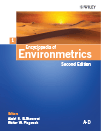Critical Loads
Abstract
In the 1960s and 1970s it became clear that air pollution was causing damage to ecosystems across the world, and in particular acid rain was thought to be damaging forests and water bodies long distances from the pollutant source. International agreements were necessary in order to reduce emissions of these pollutants, and it was therefore necessary to quantify both current damage, and the level of reductions that would reduce damage to acceptable levels. Critical loads (CLs) were therefore defined in the 1979 Geneva Convention on Long-range Transboundary Air Pollution, as ‘a quantitative estimate of an exposure to one or more pollutants below which significant harmful effects on specified sensitive elements of the environment do not occur according to present knowledge’. The first CLs were defined and calculated for acidity due to sulfur (S) deposition. These were superseded by acidity CLs due to combined nitrogen (N) and S deposition. There are now also CLs for nutrient N, and more recently ‘critical levels’ have been defined for ozone. CLs have now been defined and mapped for all natural and semi-natural areas in Europe. The data are held at the Co-ordination Center for Effects at the National Institute of Public Health and the Environment in the Netherlands (RIVM).



